TOYOTA RAV4 EV 2014 1.G Owners Manual
Manufacturer: TOYOTA, Model Year: 2014, Model line: RAV4 EV, Model: TOYOTA RAV4 EV 2014 1.GPages: 521, PDF Size: 7.44 MB
Page 461 of 521
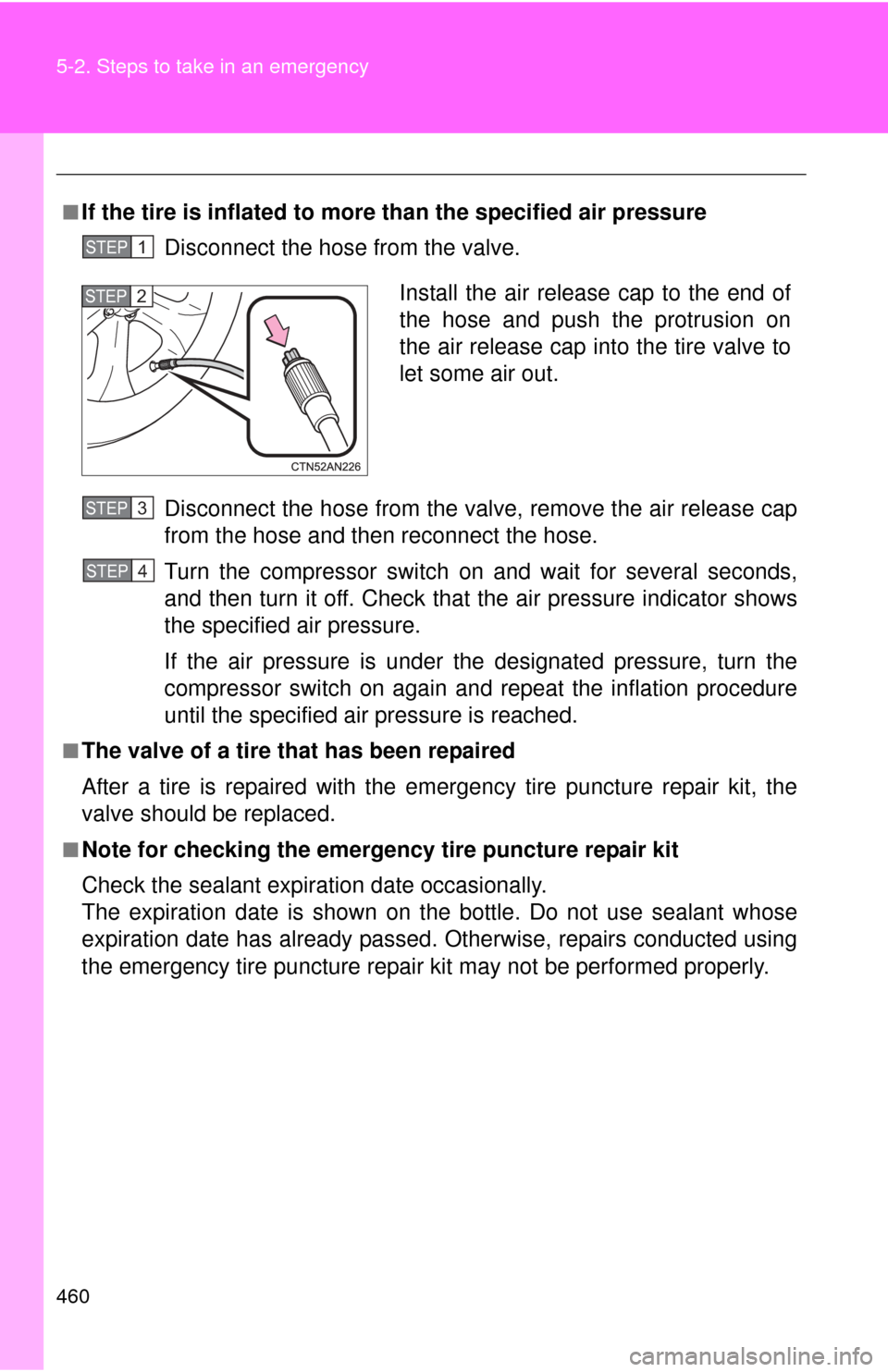
460 5-2. Steps to take in an emergency
■If the tire is inflated to more than the specified air pressureDisconnect the hose from the valve.
Disconnect the hose from the valve, remove the air release cap
from the hose and then reconnect the hose.
Turn the compressor switch on and wait for several seconds,
and then turn it off. Check that the air pressure indicator shows
the specified air pressure.
If the air pressure is under the designated pressure, turn the
compressor switch on again and repeat the inflation procedure
until the specified air pressure is reached.
■The valve of a tire that has been repaired
After a tire is repaired with the emergency tire puncture repair kit, the
valve should be replaced.
■Note for checking the emergency tire puncture repair kit
Check the sealant expiration date occasionally.
The expiration date is shown on th e bottle. Do not use sealant whose
expiration date has already passed. Otherwise, repairs conducted using
the emergency tire puncture repair kit may not be performed properly.
STEP 1
Install the air release cap to the end of
the hose and push the protrusion on
the air release cap into the tire valve to
let some air out.STEP 2
STEP 3
STEP 4
Page 462 of 521

5
When trouble arises
461
5-2. Steps to take in an emergency
■Emergency tire puncture repair kit
●The sealant stored in the emergency tire puncture repair kit can be
used only once to temporarily repair a single tire. If the sealant has
been used and needs to be replaced, purchase a new bottle at your
Toyota dealer. The compressor is reusable.
●The sealant can be used when the outside temperature is from
-40°F (-40°C) to 140°F (60°C).
●The repair kit is exclusively designed for the size and type of tires
originally installed on your vehicle. Do not use it for tires that are a dif-
ferent size than the original ones, or for any other purposes.
●The sealant has a limited lifespan. The expiration date is marked on
the bottle. The bottle of sealant should be replaced with a new bottle
before the expiration date. Contact your Toyota dealer for replace-
ment.
●If the sealant gets on your clothes, it may stain.
●If the sealant adheres to a wheel or the surface of the vehicle body,
the stain may not be removable if it is not cleaned at once. Immedi-
ately wipe away the sealant with a wet cloth.
●During operation of the repair kit, a loud operation noise is produced.
This does not indicate a malfunction.
●Do not use to check or to adjust the tire pressure.
Page 463 of 521

462 5-2. Steps to take in an emergency
CAUTION
■Do not drive the vehicle with a flat tire
Do not continue driving with a flat tire.
Driving even a short distance with a flat tire can damage the tire and the
wheel beyond repair.
Driving with a flat tire may cause a circumferential groove on the side
wall. In such a case, the tire may explode when using a repair kit.
■Caution while driving
●Store the repair kit in the luggage compartment.
Injuries may result in the event of an accident or sudden braking.
●The repair kit is exclusively only for your vehicle.
Do not use repair kit on other vehicles, which could lead to an accident
causing death or serious injury.
●Do not use repair kit for tires that are different size than the original
ones, or for any other purpose. If the tires have not been completely
repaired, it could lead to an accident causing death or serious injury.
■Precautions for use of the sealant
●Ingesting the sealant is hazardous to your health. If you ingest sealant,
consume as much water as possible, and then immediately consult a
doctor.
●If sealant gets in eyes or adheres to skin, immediately wash it off with
water. If discomfort persists, consult a doctor.
■When fixing the flat tire
●Stop your vehicle in a safe and flat area.
●Do not touch the wheels or the ar ea around the brakes immediately
after the vehicle has been driven.
After the vehicle has been driven, the wheels and the area around the
brakes may be extremely hot. Touching these areas with hands, feet or
other body parts may result in burns.
●Connect the valve and hose securely with the tire installed on the vehi-
cle. If the hose is not properly con nected to the valve, air leakage may
occur as sealant may be sprayed out.
●If the hose comes off the valve while inflating the tire, there is a risk
that the hose will move abruptly due to air pressure.
Page 464 of 521

5
When trouble arises
463
5-2. Steps to take in an emergency
CAUTION
●After inflation of the tire has comp
leted, the sealant may splatter when
the hose is disconnected or so me air is let out of the tire.
●Follow the operation procedure to repair the tire. If the procedures not
followed, the sealant may spray out.
●Keep back from the tire while it is being repaired, as there is a chance
of it bursting while the repair ope ration is being performed. If you
notice any cracks or deformation of the tire, turn off the compressor
switch and stop the repair operation immediately.
●The repair kit may overheat if operated for a long period of time. Do not
operate the repair kit continuously for more than 35 minutes.
●Parts of the repair kit become hot during operation. Be careful when
handling the repair kit during and after operation. Do not touch the
metal part around the connecting area between the bottle and com-
pressor. It will be extremely hot.
●Do not attach the vehicle speed warning sticker to an area other than
the one indicated. If the sticker is attached to an area where an SRS
airbag is located, such as the pad of the steering wheel, it may prevent
the SRS airbag from operating properly.
■Driving to spread the liquid sealant evenly
Observe the following precautions to reduce the risk of accidents.
Failing to do so may result in a loss of vehicle control and cause death or
serious injury.
●Drive the vehicle carefully at a lo w speed. Be especially careful when
turning and cornering.
●If the vehicle does not drive straight or you feel a pull through the
steering wheel, stop the vehicle and check the following.
• Tire condition. The tire may have separated from the wheel.
• Tire inflation pressure. If the tire inflation pressure is 19 psi (130
kPa, 1.3 kgf/cm
2 or bar) or less, the tire may be severely dam-
aged.
Page 465 of 521

464 5-2. Steps to take in an emergency
NOTICE
■When performing an emergency repair
●A tire should only be repaired with the emergency tire puncture repair
kit if the damage is caused by a sharp object such as a nail or screw
passing through the tire tread.
Do not remove the sharp object from the tire. Removing the object may
widen the opening and disenable emergency repair with the repair kit.
●The repair kit is not waterproof. Make sure that the repair kit is not
exposed to water, such as when it is being used in the rain.
●Do not put the repair kit directly onto dusty ground such as sand at the
side of the road. If the repair kit vacuums up dust etc., a malfunction
may occur.
■Precautions for the emergency tire puncture repair kit
●The repair kit power source should be 12 V DC suitable for vehicle
use. Do not connect the repair kit to any other source.
●If gasoline splatters on the repair kit, the repair kit may deteriorate.
Take care not to allow gasoline to contact it.
●Place the repair kit in the specifi ed storage location to prevent it from
being exposed to dirt or water.
●Store the repair kit out of reach of children.
●Do not disassemble or modify the repair kit. Do not subject parts such
as the air pressure indicator to impacts. This may cause a malfunction.
Page 466 of 521
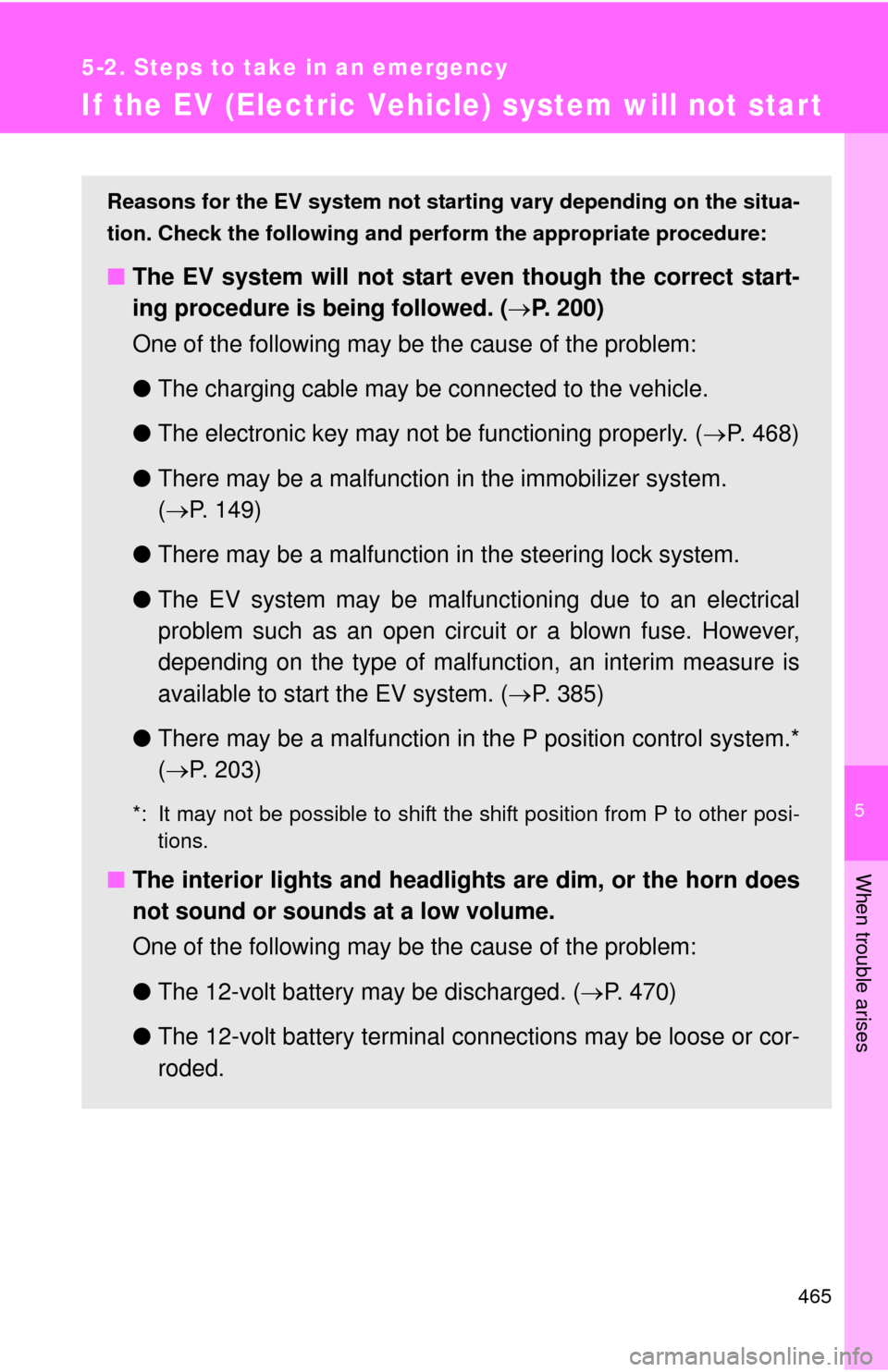
5
When trouble arises
465
5-2. Steps to take in an emergency
If the EV (Electric Vehicle) system will not start
Reasons for the EV system not star ting vary depending on the situa-
tion. Check the following and pe rform the appropriate procedure:
■The EV system will not start even though the correct start-
ing procedure is being followed. ( P. 200)
One of the following may be the cause of the problem:
● The charging cable may be connected to the vehicle.
● The electronic key may not be functioning properly. ( P. 468)
● There may be a malfunction in the immobilizer system.
( P. 149)
● There may be a malfunction in the steering lock system.
● The EV system may be malfunct ioning due to an electrical
problem such as an open circuit or a blown fuse. However,
depending on the type of malf unction, an interim measure is
available to start the EV system. ( P. 385)
● There may be a malfunction in th e P position control system.*
( P. 203)
*: It may not be possible to shift the shift position from P to other posi-
tions.
■The interior lights and headlights are dim, or the horn does
not sound or sounds at a low volume.
One of the following may be the cause of the problem:
●The 12-volt battery may be discharged. ( P. 470)
● The 12-volt battery terminal c onnections may be loose or cor-
roded.
Page 467 of 521
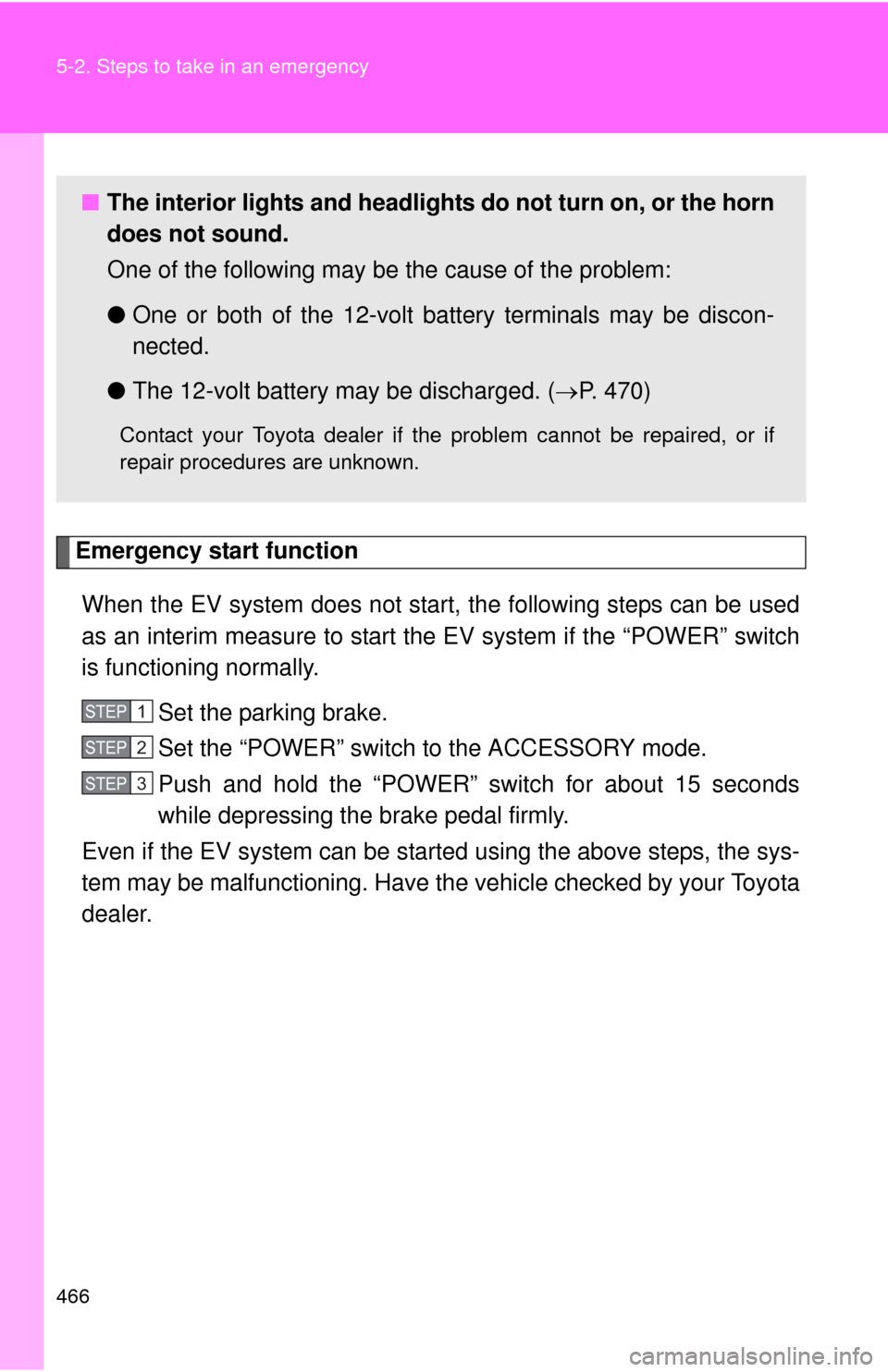
466 5-2. Steps to take in an emergency
Emergency start functionWhen the EV system does not start, the following steps can be used
as an interim measure to start the EV system if the “POWER” switch
is functioning normally. Set the parking brake.
Set the “POWER” switch to the ACCESSORY mode.
Push and hold the “POWER” switch for about 15 seconds
while depressing the brake pedal firmly.
Even if the EV system can be st arted using the above steps, the sys-
tem may be malfunctioning. Have th e vehicle checked by your Toyota
dealer.
■ The interior lights and headlights do not turn on, or the horn
does not sound.
One of the following may be the cause of the problem:
●One or both of the 12-volt ba ttery terminals may be discon-
nected.
● The 12-volt battery may be discharged. ( P. 470)
Contact your Toyota dealer if the problem cannot be repaired, or if
repair procedures are unknown.
STEP 1
STEP 2
STEP 3
Page 468 of 521
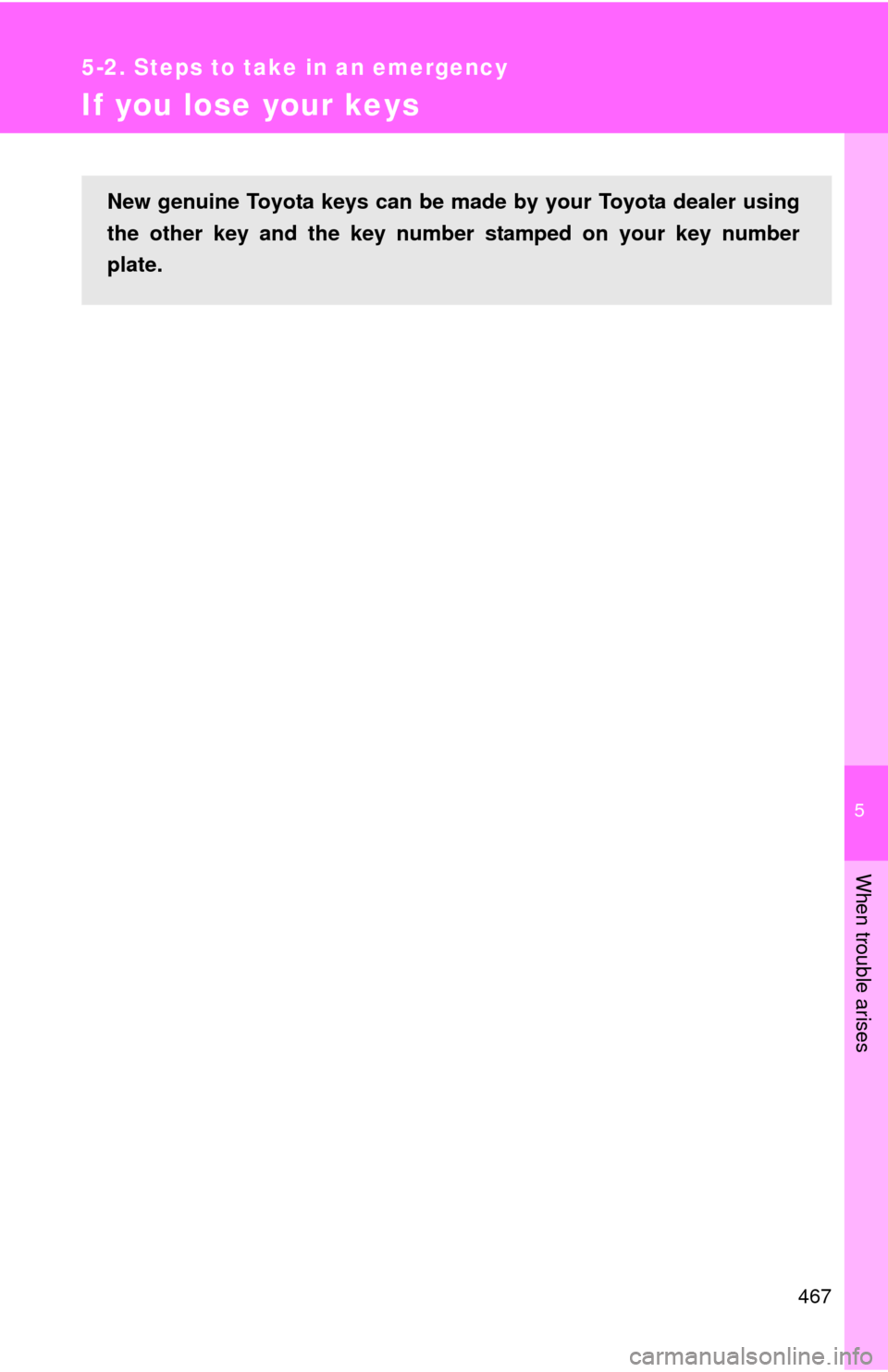
5
When trouble arises
467
5-2. Steps to take in an emergency
If you lose your keys
New genuine Toyota keys can be made by your Toyota dealer using
the other key and the key number stamped on your key number
plate.
Page 469 of 521
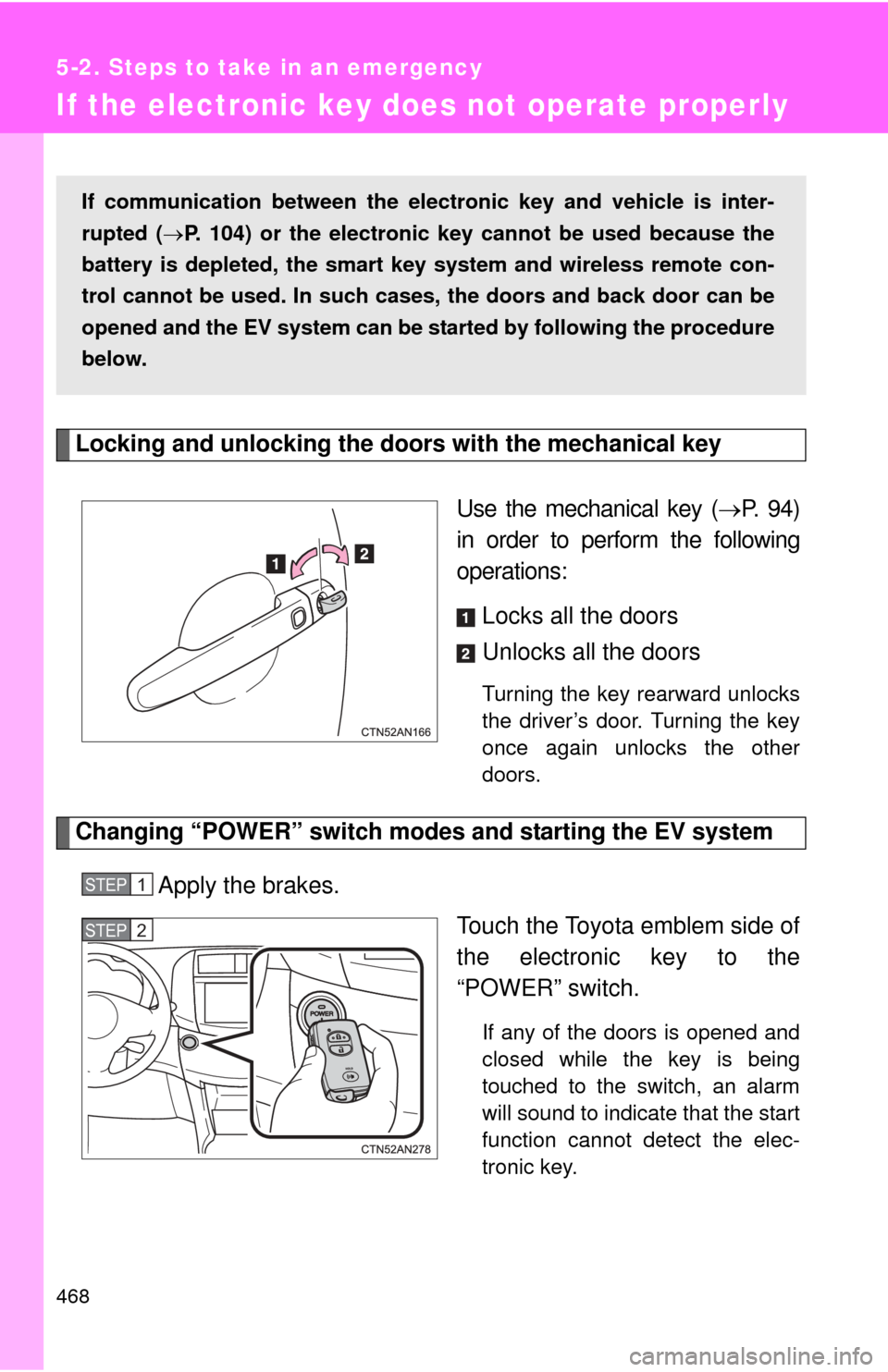
468
5-2. Steps to take in an emergency
If the electronic key does not operate properly
Locking and unlocking the doors with the mechanical key
Use the mechanical key ( P. 94)
in order to perform the following
operations:
Locks all the doors
Unlocks all the doors
Turning the key rearward unlocks
the driver’s door. Turning the key
once again unlocks the other
doors.
Changing “POWER” switch modes and starting the EV system
Apply the brakes. Touch the Toyota emblem side of
the electronic key to the
“POWER” switch.
If any of the doors is opened and
closed while the key is being
touched to the switch, an alarm
will sound to indicate that the start
function cannot detect the elec-
tronic key.
If communication between the electronic key and vehicle is inter-
rupted (P. 104) or the electronic key cannot be used because the
battery is depleted, the smart key system and wireless remote con-
trol cannot be used. In such cases, the doors and back door can be
opened and the EV system can be started by following the procedure
below.
STEP 1
STEP 2
Page 470 of 521

5
When trouble arises
469
5-2. Steps to take in an emergency
To change “POWER” switch modes:
Within 10 seconds of the buzze
r sounding, release the brake
pedal and press the “POWER” switch. Modes can be changed
each time the switch is pressed. ( P. 202)
To start the EV system:
Press the “POWER” switch within 10 seconds of the buzzer
sounding, keeping the brake pedal depressed.
In the event that the EV system still cannot be operated, contact your
Toyota dealer.
■ Stopping the EV system
Set the parking brake, push the P position switch and press the “POWER”
switch as you normally do when stopping the EV system.
■ Replacing the key battery
As the above procedure is a temporary measure, it is recommended that the
electronic key battery be replaced immediately when the battery is depleted.
(P. 383)
STEP 3